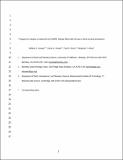| dc.contributor.author | Cassata, William S. | |
| dc.contributor.author | Shuster, David L. | |
| dc.contributor.author | Renne, Paul R. | |
| dc.contributor.author | Weiss, Benjamin P. | |
| dc.date.accessioned | 2017-07-05T20:44:21Z | |
| dc.date.available | 2017-07-05T20:44:21Z | |
| dc.date.issued | 2012-05 | |
| dc.date.submitted | 2012-04 | |
| dc.identifier.issn | 0019-1035 | |
| dc.identifier.uri | http://hdl.handle.net/1721.1/110477 | |
| dc.description.abstract | Water is not currently stable in liquid form on the martian surface due to the present mean atmospheric pressure of ∼7 mbar and mean global temperature of ∼220 K. However, geomorphic features and hydrated mineral assemblages suggest that Mars’ climate was once warmer and liquid water flowed on the surface. These observations may indicate a substantially more massive atmosphere in the past, but there have been few observational constraints on paleoatmospheric pressures. Here we show how the [superscript 40]Ar/[superscript 36]Ar ratios of trapped gases within martian meteorite ALH 84001 constrain paleoatmospheric pressure on Mars during the Noachian era [∼4.56–3.8 billion years (Ga)]. Our model indicates that atmospheric pressures did not exceed ∼1.5 bar during the first 400 million years (Ma) of the Noachian era, and were <400 mbar by 4.16 Ga. Such pressures of CO[subscript 2] are only sufficient to stabilize liquid water on Mars’ surface at low latitudes during seasonally warm periods. Other greenhouse gases like SO[superscript 2] and water vapor may have played an important role in intermittently stabilizing liquid water at higher latitudes following major volcanic eruptions or impact events. | en_US |
| dc.description.sponsorship | United States. National Aeronautics and Space Administration. Mars Fundamental Research Program (Grant MFRP05-0108) | en_US |
| dc.description.sponsorship | Ann and Gordon Getty Foundation | en_US |
| dc.language.iso | en_US | |
| dc.publisher | Elsevier | en_US |
| dc.relation.isversionof | http://dx.doi.org/10.1016/j.icarus.2012.05.005 | en_US |
| dc.rights | Creative Commons Attribution-NonCommercial-NoDerivs License | en_US |
| dc.rights.uri | http://creativecommons.org/licenses/by-nc-nd/4.0/ | en_US |
| dc.source | Prof. Weiss via Michael Noga | en_US |
| dc.title | Trapped Ar isotopes in meteorite ALH 84001 indicate Mars did not have a thick ancient atmosphere | en_US |
| dc.type | Article | en_US |
| dc.identifier.citation | Cassata, William S. et al. “Trapped Ar Isotopes in Meteorite ALH 84001 Indicate Mars Did Not Have a Thick Ancient Atmosphere.” Icarus 221.1 (2012): 461–465. | en_US |
| dc.contributor.department | Massachusetts Institute of Technology. Department of Earth, Atmospheric, and Planetary Sciences | en_US |
| dc.contributor.approver | Weiss, Michael | en_US |
| dc.contributor.mitauthor | Weiss, Benjamin P | |
| dc.relation.journal | Icarus | en_US |
| dc.eprint.version | Author's final manuscript | en_US |
| dc.type.uri | http://purl.org/eprint/type/JournalArticle | en_US |
| eprint.status | http://purl.org/eprint/status/PeerReviewed | en_US |
| dspace.orderedauthors | Cassata, William S.; Shuster, David L.; Renne, Paul R.; Weiss, Benjamin P. | en_US |
| dspace.embargo.terms | N | en_US |
| dc.identifier.orcid | https://orcid.org/0000-0003-3113-3415 | |
| mit.license | PUBLISHER_CC | en_US |
| mit.metadata.status | Complete | |
